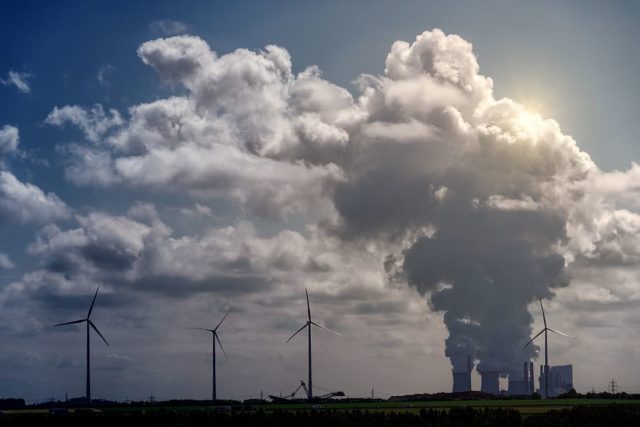The stark drop in energy demand due to the coronavirus pandemic will remove some 2.5 years’ worth of energy sector emissions between now and 2050, according to research company BloombergNEF’s (BNEF) latest New Energy Outlook 2020 (NEO 2020).
BNEF’s latest projection of the evolution of the global energy system over the next 30 years, using its proprietary Economic Transition Scenario, shows that emissions from fuel combustion peaked in 2019. Down approximately 10% in 2020 as a result of the Covid-19 pandemic, energy emissions rise again with economic recovery, but never again reach 2019 levels. From 2027 on, they fall at a rate of 0.7% per year to 2050.
This prospect is based on a huge build-out of super-competitive wind and solar power, the uptake of electric vehicles and improved energy efficiency across industries. Together, wind and solar account for 56% of global electricity generation by mid-century and together with batteries take 80% of the $15.1 trillion invested in new power capacity over the next 30 years, according to the analysis. An additional $14 trillion is invested in the grid to 2050.
Coal-fired power peaks in China in 2027 and India in 2030, collapsing to 12% of global electricity generation in 2050. In contrast, gas is the only fossil fuel to keep growing throughout the outlook, up 0.5% year-on-year to 2050, growing 33% in buildings and 23% in an industry where there are few economic low-carbon substitutes.
Yet, despite the progress of the energy transition, and the decrease in energy demand brought by Covid-19, BNEF still sees energy sector emissions putting the world on course for a 3.3 degrees Celsius temperature increase by 2100.
Jon Moore, CEO of BNEF, said: “The next ten years will be crucial for the energy transition. There are three key things that we will need to see: accelerated deployment of wind and PV; faster consumer uptake in electric vehicles, small-scale renewables, and low-carbon heating technology, such as heat pumps; and scaled-up development and deployment of zero-carbon fuels.”
Whereas NEO previously focused on the electricity sector, this year’s report includes detailed chapters on industry, buildings and transport to give a full-coverage, economics-led view of the energy economy to 2050. The report also features a Climate Scenario investigating a clean electricity and hydrogen pathway to holding temperatures to well below 2 degrees.
Seb Henbest, chief economist at BNEF and lead author of NEO 2020, adds: “Our projections for the power system have become even more bullish for renewables than in previous years, based purely on cost dynamics. What this year’s study highlights is the tremendous opportunity for low-carbon power to help decarbonize transport, buildings and industry – both through direct electrification and via green hydrogen.”
NEO 2020 sees total oil demand peaking in 2035 and then falling 0.7% year-on-year to return to 2018 levels in 2050. Electric vehicles are projected to reach upfront price parity with internal combustion vehicles in the years leading up to the mid-2020s. After that their adoption accelerates, eating more and more into the oil demand growth that otherwise comes from aviation, shipping and petrochemicals.
Related articles:
Photovoltaics dominate as new energy-generating technology
Green bonds market passes $1 trillion milestone amid global turmoil
Ultimately, energy use in buildings, industry and certain parts of the transport sector, such as aviation and shipping, have few cost-competitive low-carbon options, and so remain heavily reliant on gas and oil products.
Matthias Kimmel, senior analyst at BNEF and co-author of the report, commented: “To stay well below two degrees of global temperature rise, we would need to reduce emissions by 6% every year starting now, and to limit the warming to 1.5 degrees C, emissions would have to fall by 10% per year.”
NEO 2020 Climate Scenario:
- BNEF has produced a Climate Scenario, to sit alongside its core Economic Transition Scenario. This year, it investigates a clean electricity and green hydrogen pathway to holding temperatures to well below 2 degrees.
- This pathway describes a low-carbon future energy economy supplying 100,000TWh of clean electricity by 2050. This is five times all the electricity produced in the world today and would require a power system that is 6-8 times larger in terms of total capacity. Two-thirds of this energy would go to direct electricity provision in transport, buildings and industry, the remaining third to manufacturing hydrogen.
- For green hydrogen to supply just under a quarter of final energy we would need 801MMT of fuel and an additional 36,000TWh of electricity – that’s 38% more power than is produced in the world today. Doing this with wind and PV might be cheapest, but it would require 14TW of capacity covering 3.5 million square kilometers – an area roughly the size of India.
- According to BNEF, clean electricity and green hydrogen pathway requires between $78 trillion and $130 trillion of new investment between now and 2050 to cover growth in electricity generation and the power grid, as well as manufacturing, storing and transporting hydrogen.
Learn more about the report.



